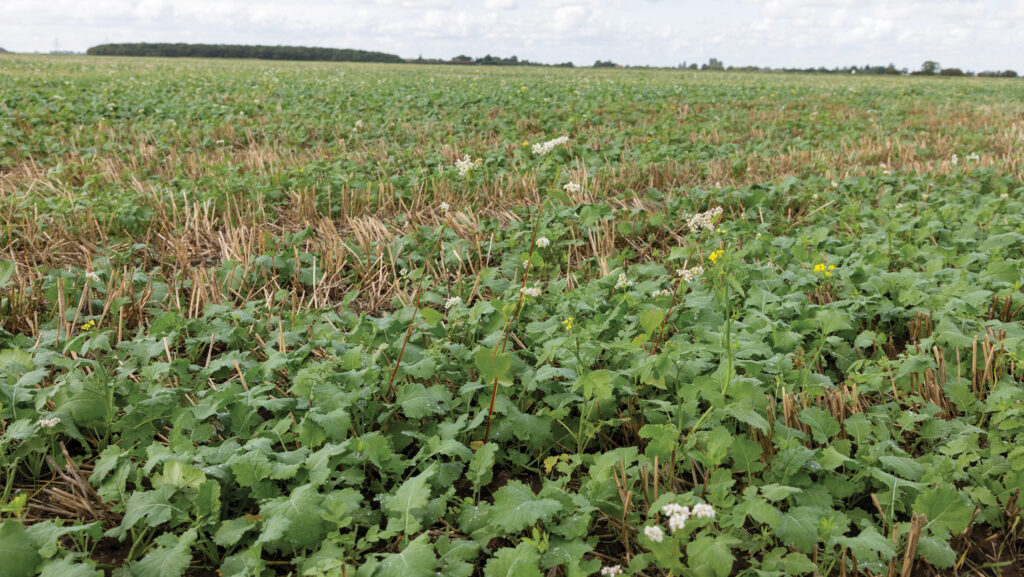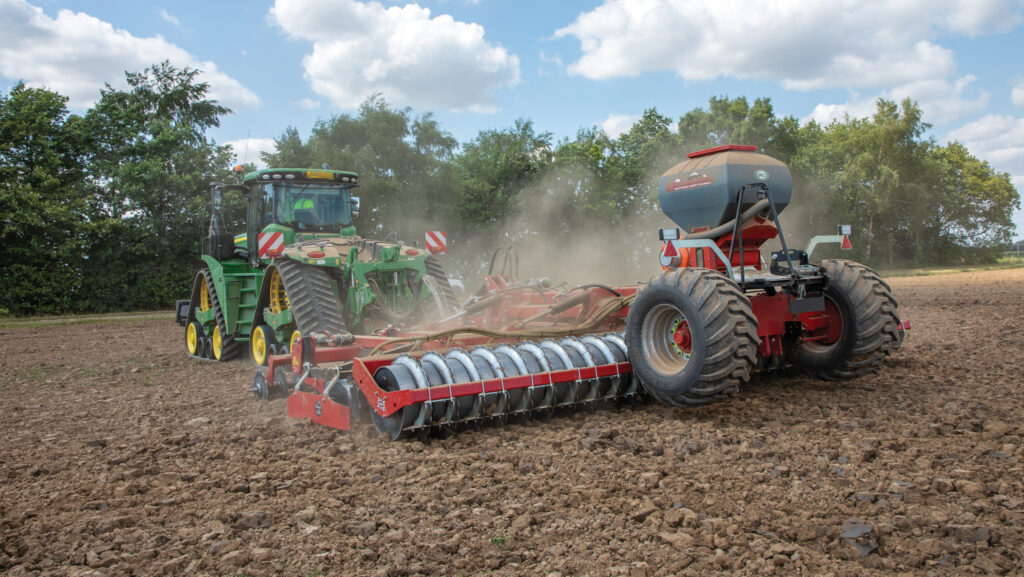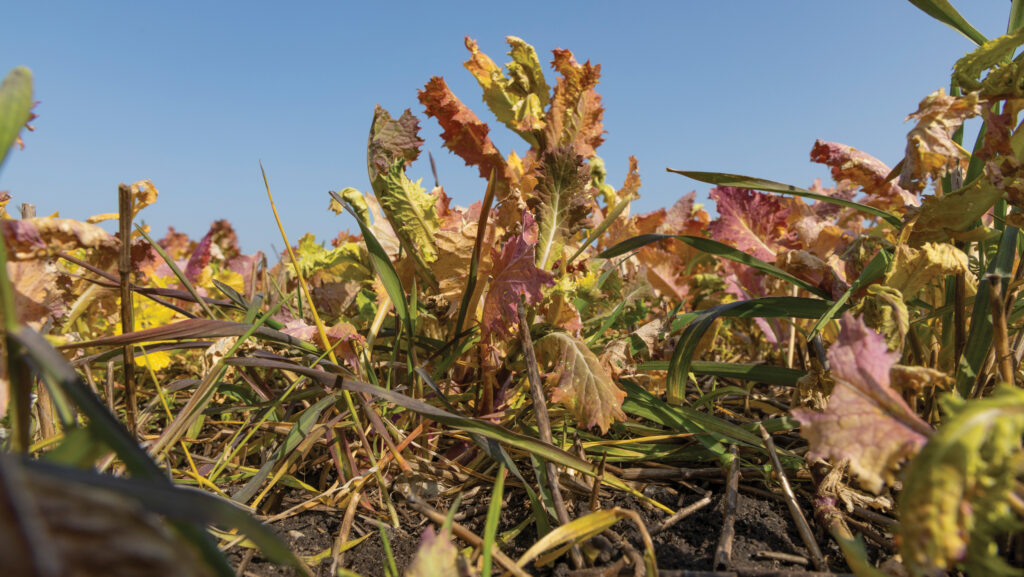How to get the most from SAM2 overwinter cover crops
 © GNP
© GNP Many growers will have experimented with overwintered cover crops in recent seasons, with, it’s fair to say, varying levels of success.
In terms of area, overwintered cover crops is the third most popular management action in the 13,900 live SFI 2023 agreements, according to Defra figures up to 1 April 2024, covering 124,000ha. In total, about 17% had chosen the SAM2 multispecies winter cover option, which pays £129/ha.
A further 70,700ha of winter cover crops (SW6) are in 1,400 live Countryside Stewardship agreements, while some growers may benefit from payments from private companies, such as water utilities, all of which helps offset some financial risk.
See also: How to get the best out of IPM3 companion cropping in SFI
In SFI the action’s aim is to have a well-established multispecies cover crop over the winter months, which usually include December, January and February.
Ian Gould at seed specialist Oakbank explains that its purpose is to cover and protect the soil surface from weather and temperature extremes, keeping soil in place.
“There’s also good evidence of the ability of cover crops to capture any unused nutrient that’s been applied to the previous crop to stop it leaching away, which also saves the farm money as it keeps the nutrients within the system,” he says.
Cover crops play a role in improving soil structure through supporting soil biology, he adds.
“I firmly believe the only thing that creates soil structure is biology.
“The cover crops pump exudates into the soil, feeding soil biology, which in turn produce organic glues such as glomalin that start to build soil aggregates.
“That can help minimise cultivations because the plants are restructuring soil through their roots rather than using metal to move around the soil.”
Another potential benefit of growing cover crops is their role in helping to integrate livestock into the rotation.
“That’s a positive when done appropriately at the right time of year,” Ian says.
Drilling date and method
The key to success with winter cover crops is getting them established as soon as possible after harvest of the previous crop.
Earlier drilling helps reduce the risk of uncovered soil drying out post-harvest, making establishment harder. It also gives the cover crop more sunshine hours to photosynthesise and drive exudates into the soil, Ian explains.

© GNP
Typically, there is increased crop volume, canopy size and nutrient capture from establishing a winter cover in the middle of August compared with in September.
Attempting to establish even earlier by spinning seed into a standing crop is an option, but can be hit and miss, Ian says.
“It only works for a limited range of species, which tend to be those with round hard seeds, like radishes, mustards and vetches, because they have the ballistic properties that will let them fall down among the crop.
“Species like linseed and phacelia don’t seem to do as well in that system.”
Another option for cover crop establishment is to distribute seed using a Stocks seeder behind the combine header, putting the seed underneath chopped straw and then distributing the straw evenly using a straw rake.
“But the best results always seem to come from drilling or at least broadcasting with a degree of incorporation, while making sure the previous crop residue is spread evenly,” Ian says.
This could be achieved using a shallow cultivator such as Vaderstad Carrier or similar with a seeder box. “It’s simple to operate, which widens the number of people who could do the job.”
For SAM2, at least two species need to be drilled from one or more of the brassicas, legumes, grass and cereals, and herb families need to be drilled, but Ian recommends at least three species from three different plant families, based on evidence from experiments by the likes of Jena in Germany, and backed up by research from soil experts such as Joel Williams and Dr Christine Jones.
“The more diversity, the more different types of root exudates you are providing and the more types of soil biology you are feeding,” Ian says.
“That doesn’t have to mean the cover crop mix is more expensive – it just means there is more functional diversity.”
In cover crops grown over summer, where there is more time to obtain benefits, the number of species might increase to seven or eight, but three or four should suffice in winter cover crops for SAM2, Ian adds.
Species choice
Ian says: “Species choice will depend on a number of factors, such as rotation – not just next year but what will be grown in the next four or five years; the previous crop and when it will be harvested.
“For example, if you were growing winter barley, you would have a reasonable expectation you could get the cover crop planted in late July, so you could get more benefit from it and, therefore, spend more money than one that would be planted in late August.”
The following crop, and how far in advance the cover crop will likely need to be terminated, should also play a part in species selection, Ian suggests.
“The turnaround for the next crop includes how quickly the nutrients in the cover crop become available, as well as the ability to create a good growing environment for the spring cash crop.”
Before a spring cereal, Ian suggests growing a cover crop with a low carbon to nitrogen ratio, which will return nutrients to the system sooner to give better conditions for establishing the crop more quickly.
Typically, that means avoiding cereals in cover crop mixes, while using more legumes, for example.
Research by Dr Amelia Hood at the University of Reading suggests that growing a mix of winter-intolerant species, such as buckwheat or berseem clover, and winter-hardy plants could also be helpful for creating a good growing environment.
Ian explains: “Having some elements that die out naturally helps create a bit of space, meaning you start to thin the cover crop, allowing wind and air to the soil surface, helping to dry it out.
“Otherwise, for example, with a thick crop of oats and vetch the surface under the cover can be quite wet if you don’t kill it off soon enough.”
Termination
Judging how long to terminate a cover crop before drilling a spring cereal, in particular, is crucial to avoiding yield penalties.
In SAM2 the rules state this must be not more than six weeks before spring crop establishment, although it can be before the end of the winter months if you are establishing an early-sown spring crop.
That can be on the cusp of not being enough time, especially on heavier soil types, Ian notes.
“Killing off cover crops too soon doesn’t have the same number of downsides as too late.”
While this will mean soil being left uncovered for longer, the cover crop root mass should bind soil together so it will be more stable than uncovered, cultivated land.

© GNP
Glyphosate remains the most useful tool for terminating covers.
Even where other techniques such as grazing, crimping or rolling on a frost are used, they often get glyphosate after, Ian points out.
“One year’s research by one of the water companies also suggested that nutrients are released more quickly for the following crop where glyphosate is used.”
Where the cover is being followed by non-cereal spring crops, such as peas, beans or maize, termination date is less important, with it being possible in the case of maize to direct drill straight into the cover.
“With later drilling dates, soil is warming and there naturally seems to be more nutrients available,” Ian says.
Things to watch out for with cover crop species selection
- Species that could create disease or pest carryover into the next cash crop
- Adding legumes where there are peas and beans in the rotation. Latest research by PGRO is dispelling some concerns in this area for species such as vetch and berseem clover, so check for latest findings. Radish in vining pea rotations could be of higher concern as a host for foot rots
- Mustard and radish in rotations with oilseed rape could increase club root and slug risk. Radish is probably best for mopping up excess nitrates in soils
- Species that could increase wireworm risk in potato rotations

